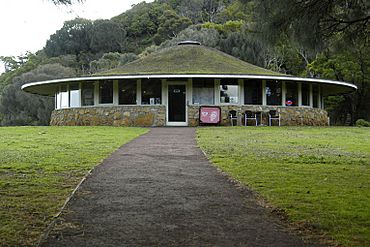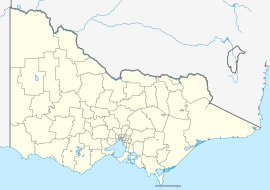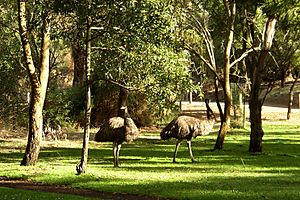Tower Hill Wildlife Reserve facts for kids
Quick facts for kids Tower Hill State Wildlife ReserveVictoria |
|
|---|---|
|
IUCN Category VI (Managed Resource Protected Area)
|
|

Tower Hill Visitor Centre
|
|
| Nearest town or city | Warrnambool |
| Established | 1982 |
| Area | 6.24 km2 (2.4 sq mi) |
| Managing authorities | Parks Victoria Worn Gundidj Aboriginal Cooperative |
| See also | Protected areas of Victoria |
| Tower Hill Wildlife Reserve | |
|---|---|
| Official name: Register of the National Estate | |
| Designated | 30 June 1992 |
| Reference no. | 15250 |
| Official name: Victorian Heritage Register | |
| Designated | 8 March 2007 |
| Reference no. | H2114 |
Tower Hill Wildlife Reserve is a special protected area in Victoria, Australia. It is about 275 kilometers west of Melbourne and 15 kilometers north-west of Warrnambool. This reserve is home to an extinct volcano called Tower Hill and a large wetland. The whole area covers about 614 hectares.
Tower Hill was first made a national park in 1892. However, the land became quite damaged over time. In 1961, a big project started to replant native trees and bring back native animals. Today, the reserve is full of healthy native plants and animals. You can see koalas, wallabies, and possums living there. The Worn Gundidj Aboriginal Cooperative works with Parks Victoria to look after the park.
Contents
History of Tower Hill Reserve
Tower Hill has a very long and interesting history. Aboriginal people have lived in this area for thousands of years. Scientists have found old Aboriginal campsites, called kitchen middens, at Tower Hill. These middens contain bones of animals like the Tasmanian devil from 5000 years ago.
Tools made of greenstone and other artefacts have also been found. These tools show that Aboriginal people were living here when the volcano erupted. New studies using special dating methods show that the Tower Hill volcano erupted at least 34,000 years ago. This means people were in the area even before these huge eruptions.
The local Aboriginal people were the Koroitgundidj. This area was a very important place for them to find food. Their descendants still have strong connections to this land today.
Changes After European Settlement
After Europeans arrived, much of the native bush was cut down. The land was then used for farming and digging up rocks (called quarrying). Even though Tower Hill became Victoria's first national park in 1892, the land and its wildlife continued to suffer.
Things started to change in 1961. The area was declared a State Game Reserve, and a huge project began to replant native plants. Workers used an old painting from 1855 by an artist named Eugene von Guerard to help them know which plants to put back. By 1981, about 25,000 trees and shrubs had been planted.
Native animals were also brought back to the reserve. In the 1980s, populations of koalas, grey kangaroos, wallabies, echidnas, brushtail and ringtail possums, and sugar gliders were successfully reintroduced. More than 160 types of birds also live there. These animals are still thriving in the reserve today.
The Visitor Centre
The Tower Hill Visitor Centre was finished in 1969 and opened in 1970. It is located right in the middle of the volcano's cones. A famous architect from Melbourne named Robin Boyd designed the building. He used local limestone to build it.
Boyd loved nature and designed the building to fit in perfectly with its surroundings. Its round shape and sloping roof look like the hills of the volcanic island.
Why is it called Tower Hill?
No one is completely sure how Tower Hill got its English name. Some people think it was named in the 1840s because it looked like a castle. Others believe a sailor from Glasgow named it after a place called Tower Hill in Scotland.
Exploring Tower Hill Reserve
The reserve is a great place to learn about nature and history. It includes the extinct Tower Hill volcano and its surrounding wetland. The entire area covers about 614 hectares.
Since 2002, the Worn Gundidj Aboriginal Cooperative has worked with Parks Victoria to manage the Visitor Centre. Staff, including descendants of the original Aboriginal inhabitants, share information about the area's geology, plants, animals, and cultural heritage. They do this through displays and guided bushwalking tours. These tours have become very popular, with visitor numbers doubling in recent years.
The park attracts almost 300,000 visitors every year. There have been talks about changing Tower Hill's status from a State Game Reserve to a National Park. This would bring more rules to protect the area even further.
Future Plans for Tower Hill
The Victorian Government has plans to improve the facilities at Tower Hill. A masterplan from 2020 suggests spending more than $11 million on upgrades. These plans include making toilets and walking trails more accessible for everyone. There are also ideas for new places to stay and a restaurant.
Protecting Tower Hill's Heritage
Tower Hill is recognized as an important historical and natural site. It was added to the Victorian Heritage Register in 2007. It was also listed on the now-closed Register of the National Estate in 1992.
The wildlife reserve is classified as an IUCN Category VI protected area. This means it is a protected area where natural resources can be used sustainably.
Images for kids




